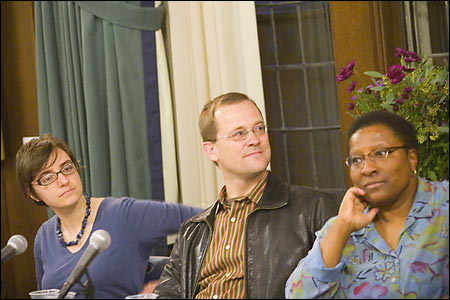Panel takes on domestic violence
HDS discussion confronts public health problem
“Where is the church in the midst of this public health problem? And what does our faith call on us to do?”
Those were the two questions with which Cheryl Giles, the Francis Greenwood Peabody Professor of the Practice in Pastoral Care and Counseling, introduced a panel discussion on domestic violence, subtitled “Awareness and Engagement in Faith and Non-Faith Communities.”
The event, which took place Nov. 30 at the Harvard Divinity School’s Andover Hall, was sponsored by the HDS Women’s Caucus.
Giles, a core faculty member of the Divinity School’s Program in Religion and Secondary Education, told the audience of several dozen that the U.S. Centers for Disease Control maintain that “intimate partner violence” – physical, sexual, or psychological violence between current or former spouses or sexual partners – affects 32 million people in the United States.
However, like many others in this field, Giles also said that “most” intimate violence is not reported.

Though they focused on domestic violence, the panelists put the issue into a larger context. One of them, Curt Rogers, founder and executive director of the Gay Men’s Domestic Violence Project, said, “Violence is learned behavior, intermingled with all the other kinds of violence we accept in our society.”
Another panelist, Nicole Sotelo, an abuse survivor and the author of “Women Healing from Abuse: Meditations for Finding Peace,” introduced the work of psychiatrist Judith Herman, author of “Trauma and Recovery: The Aftermath of Violence – from Domestic Abuse to Political Terror.” Sotelo, M.Div. ’05, explained how she has adapted the three stages of recovery that Herman suggests for victims of abuse: establishing safety; remembrance and mourning; and reconnection.
M. Christian Green, in her third year as a visiting lecturer in ethics at HDS, introduced the work of Mary Susan Miller, author of “No Visible Wounds: Identifying Non-Physical Abuse of Women by their Men,” to stress that physical abuse is only one aspect of intimate violence. She also presented a couple of video clips to shed light on the issues of friends witnessing domestic abuse.
One was a scene from the 1991 movie “Fried Green Tomatoes,” in which a woman peers through a screen door to see that the friend she’s come to visit has a “shiner,” presumably administered by the hulking husband who looms menacingly behind her.
The other clip was from the TV series “Sex and the City,” in which a conversation that character Carrie Bradshaw has at a friend’s apartment one evening awakens the friend’s early-to-bed husband and brings him, enraged and spewing obscenities, into the living room. Carrie is later shown musing with other friends about the wisdom of telling someone she should break up with her husband.
Although researchers say most domestic violence involves men attacking women, Rogers was there to make clear that men can be victims, too.
“Many of you probably have never heard a survivor’s story coming out of the mouth of a gay man,” he said as he recounted his own experience in a violent relationship, which included a 3 1/2-hour struggle with a partner who was trying to kill him and who ultimately hanged himself.
“No shelters would take me in,” he said. Fortunately, his employer stood by him, and his employer’s parents – initially strangers to him – took him in for a month and a half when he was in effect in hiding from his abusive partner. “I consider myself extremely lucky.”
In the years since, the organization Rogers founded has worked to make resources available for gay men in abusive relationships. It has also worked on education, on raising awareness of domestic violence as a gay men’s issue, too, and trying to get those involved to “self-identify” and come forward for treatment.
However, all the panelists seemed to feel challenged by how, in the words of one questioner from the floor, “to speak to the abuser in the pew to get them to change.”
Another issue that surfaced in the discussion was the challenge of religious language.
Sotelo noted that the terminology of Christianity – the only religion explicitly referenced in the discussion – can be unhelpful to a woman trying to extricate herself from an abusive relationship. References to womanly submission, or even to Jesus as a male authority figure, can be problematic, she said.
But she also said she found it helpful to see Jesus as a model of nonviolence and of inclusiveness of women – as well as one unafraid to use righteous anger as a motivating force for change, as in the episode in the Christian scriptures known as the “cleansing of the temple.”
“We should be outraged at the injustice being done to us and like Jesus do what we can to stop the violence,” she said. “We should note, though, that Jesus does not … hit the money-changers or those who sold doves, but overturns tables and seats to keep them from continuing their activity. We, too, must do what we can to overturn the abuse being done to us.”




